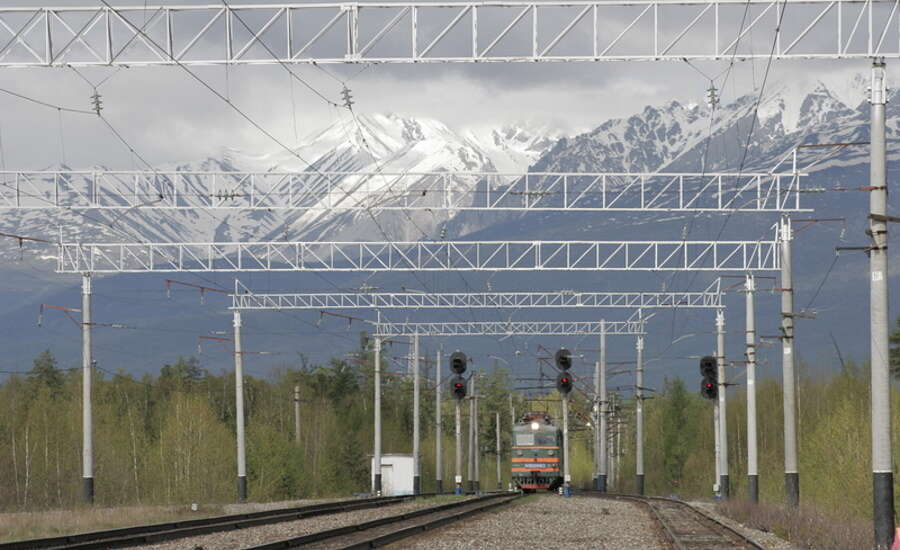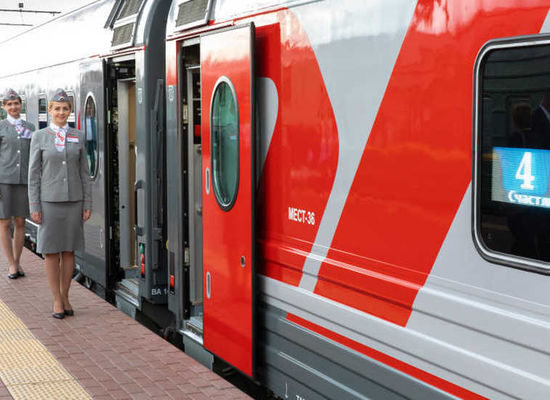Vladivostok to Moscow Trains
Learn about the longest train journey on Earth
Vladivostok to Moscow Train Route
Traveling from Vladivostok to Moscow on the Trans-Siberian Railway is a 6-7-day adventure offering an unmatched view of Russia on the longest train route in the world.
The famous Rossiya train, as well as another, non-branded train, travel between the two cities, offering views from Siberian taiga to the western pine forests. And electronic tickets on both trains convenient booking for this unforgettable experience. The same trains run on the Moscow to Vladivostok route.
Vladivostok to Moscow Train Tickets
based on 59 customer reviews
Frequently Asked Questions From Our Travelers
It takes 7 days if you travel non stop. The distance between Vladivostok and Moscow is 9,289 km.
The price largely varies with the season and level of comfort you choose. You get the lowest price, approx $120, if you travel in 3rd class from October to February. If you prefer travelling in summer in a 1st class cabin, each ticket will cost you approximately $1000 or more. Also, you get the lowest price if you book your tickets well in advance, more than 90 days before the trip.
Russian trains are basically safe. Train corridors are patrolled by conductors and a police officer; train compartments are equipped with locks and also doors can be chained from the inside. When you travel, use common sense, keep your documents and money close to yourself and don't accept alcohol or any drinks from strangers.
In fact, there's no such train called "The Trans-Siberian Express". Trans-Siberian is the name of the train route from Vladivostok to Moscow - the longest train route in the world. At the moment there are 2 trains covering the entire distance: the famous branded train #001/002 Rossiya and a regular passenger train #061/062
The distance between Vladivostok and Moscow is 9,289-kilometer. The non-stop Vladivostok - Moscow train trip takes 6 days.
The train stops for 3-5 minutes in small towns and for 20-50 minutes in larger cities. There is not enough time for sightseeing, you can only go out of the train to walk along the platform or to buy some instant food or drinks from the station kiosks.
Yes, most of the trains offer men-only, women-only and mixed 1st class and 2nd class cabins.
Some of the Vladivostok to Moscow trains have showers on board. You can use them for a small fee, approx $5. Please ask the conductor if a shower is available.
There are three ticket types available on Vladivostok to Moscow trains, all of them come with sleeping berths. A 1st class ticket is a cabin for 2 passengers, there are 2 lower sleeping berths. 2nd class cabins have 2 lower and 2 upper berths, 3rd class doesn’t have any closed cabins, the car has 54 sleeping berths. All berths come with bed linen, pillows and blankets.
Testimonials
“
Booked several trips with RussianRail
I have used RussianRail for six legs of a trip from Vladivostock to Astana and each time the web booking system has been efficient and simple to navigate. Additionally I had occasion to communicate with the office to investigate possibilities and the responses have been immediate and courteous. I only wish that I was able to book my train travel from Kazakhstan onwards with them as the KZ site is hopeless compared to Russianrail. I certainly have no problem in recommending RR.
“
Great service - highly recommended
We used Russian Rail to book the second leg of our Trans Siberian journey, going from Irkutsk to Vladivostok on the 002 Rossiya. The booking process was seamless. What really impressed us was that they refunded us a considerable amount when the exchange rate had changed in our favour on the day of booking. Thank you, Russian Rail, for your honesty and integrity. We would not hesitate to recommend you to other rail users.
“
Booked several trips with RussianRail
I have used RussianRail for six legs of a trip from Vladivostock to Astana and each time the web booking system has been efficient and simple to navigate. Additionally I had occasion to communicate with the office to investigate possibilities and the responses have been immediate and courteous. I only wish that I was able to book my train travel from Kazakhstan onwards with them as the KZ site is hopeless compared to Russianrail. I certainly have no problem in recommending RR.
“
Booking through your company made our life easier
Booking through your company made our life easier when organising such a complex trip from our perspective. Communication was excellent and to break the trip into four parts from Beijing/Ulaan Baatar/Urkutsk/Moscow/St Petersburg this was essential. We would recommend tour company.
“
Perfectly on track
Russian Rail made booking my entire Trans-Siberian adventure incredibly simple. Navigating a foreign system can seem intimidatingly opaque, not least with an unfamiliar alphabet and remote stations, but Russian Rail made it transparent. The site provided complete clarity and therefore complete freedom to choose the times, cabins, and stops that I wanted, even at the last minute. The booking process was easy and swift. Fantastic!
“
One of the best trips I've been on
It was one of the best trips I've been on. The train ride, the people and the views. It is a must do. Thank you for helping me with my booking and making the reservation process simple.
Trans Siberian Railway- A Glimpse into History
Introduction
The Trans Siberian Railway has an intriguing and interesting history. Its routes are just as intricate as its establishment story is. Today, we’re going to take a glimpse into the history of one of the most fascinating railways of history.

Photo on RZD.ru
Trans Siberian Railway- How it All Began
Tsar Alexander III was the first to perceive the idea of the construction of this railroad, back in 1891. When the work began, the railway route started spreading out in different directions, starting from West Moscow and stretching all the way till East Vladivostok.
In this network, the railway covers immediate reaches that lie along the path of the Transbaikal Railway, the Mid-Siberian Railway and other lines too. The Chinese had first secured the permission to start building a line right from the Transbaikal Region and across Manchuria, as the original plan.
By 1901, this plan did come to fruition but because of the Russo-Japanese war, there were fears of a possible takeover of Japan between 1904-05. This is why the Chinese diverted their plan and ended up making a tricky alternative route from Amur Railway to Vladivostok.
The war that broke out in between caused the Trans Siberian Railway to have two completion dates: one in 1901 and the other in 1916. The second route was wholly within Russian territory, creating a historical landmark for Siberia.
This alternative route also opened up major areas of industrialization, settlement and unfortunately, even exploitation.
Trans-Manchurian Express
This line coincided as far as Tarskaya with the Trans-Siberian line and lies on the east of Baikal at a distance of just a few hundred miles. You can track this line heading southeast into Chinese territory near Zabaikalsk and heading downwards to Beijing. Moscow to Beijing trains on this route cover a distance of 9001 kilometers!
The Chinese also took full control of the Trans-Manchurian line after the World War II. They renamed it to Ch’ang-ch’un Railway and have since then incorporated a series of spur lines from the trans-Siberian line.
The construction lasted from 1974 to 1989, comprising of a route across Taiga, permafrost and Swamps.
Trans-Mongolian Express
This line came into existence between 1940 and 1956 and sat on the eastern shore of Lake Baikal. This line is mainly between Ulan-Ude and close to Beijing, the Chinese capital. You can follow these tracks southward to Mongolia and watch it cross the Gobi desert. The entire routes measures approximately 7867 kilometers, all the way from Moscow to Beijing.
BAM- Baikal Amur Magistrate
We saw this line fist in 1984, which started from Taishet and made its way to the Pacific Ocean. It stretches towards the northeast of Khabarovsk, which you can find at Sovertskaya Galan. You will find this line running parallel to our Tran Siberian Railway and is approximately 3843 Kilometers long.
If you search for advertisements or contact travel agencies for arranging a trip on this route, you will not have any luck with it. The fact is that there isn’t one particular train running on this track; there are several different trains running along this route. In fact, one may even ride a bus if this is the destination they are heading to.
Trans Siberian Railway- Historical Journey
When Alexander first perceived this project, it was due to the economic problems running rampant due to the sheer size of Russia back then. Little did he know that once the project starts developing, it would not only address multiple economic problems but also become a matter of great national pride.
But like any project of this magnitude, delays are variations are inevitable, which is what happened with Trans-Siberian too. Apart from the very noble motivations behind it, the railway saw its fair share of planning hazards and obstacles and had to wait patiently till construction finally began.
By the mid of nineteenth century, the railroad’s construction came as a proposal on the outskirts of Siberia but that too was merely the beginning of a long, complicated story. The main problem initially was preventing foreign influence into the railroad’s construction, because foreign companies were all rallying for railway projects then.
However, the Russian Tsars were adamant about keeping foreign influence well away from the Far East and Siberia. They reigned supreme in this cause and finally gained approval to use the Russian treasury for building the road.
The railroad’s story finally made headway 25 years later after its proposal. The Emperor Alexander finally put his foot down and stated he had had enough of ideas and wanted only action now. By 1887, three research expeditions were in place and soon they went to look at the lands where the grand Trans-Siberian would develop.
By rejecting foreign funds, the Russian authorities had also established a firm nationalist bent. Due to this, there was a firm law that the Siberian Railroad would only be a people’s affair and nothing else. For this, they would only use Russian materials and employ Russian people to work on the railroad.
The February of 1891 was the momentous time when the construction finally began, launching simultaneously at Chelyabinsk and Vladivostok.

Photo on RZD.ru
Vladivostok- The Marking Point
By this time, Emperor Alexander was in fine spirits and highly determined about the Siberian railroad project. He commissioned his son to launch the construction of the great Siberian railroad. He also firmly instructed him to pay special attention to uniting Siberian nature’s rich yields with the Russian Railway network.
The Emperor couldn’t have chosen a better person for the task because his young, enthusiastic son did more than justice to the task. He accomplished what his father had desired and laid the ground with the first rock and silver plate himself.
The authoritative figures and those associated with the project partook of a special service on May 31st, 1891 to mark the initiation of the construction.
A Challenging Journey
The project development and construction journey was not an easy feat. The whole project had to pit against severe climatic conditions and impassable areas. The workers had to make their way through thinly-populated areas and the tricky Taiga area.
The taiga was itself an insurmountable challenge, what with its many large rivers, districts and waterlogged areas. Let’s also not forgot the several lakes in the way, plus the permafrost which was another battle to tackle.
However, even these obstacles paled in comparison to the mountains that Russian workers had to blow up in the Baikal region for construction purposes. The railway tunnels and railway bridges could not have taken shape without eliminating these mountains out of the way.
Besides all this, the construction cost, manpower and other logistical issues remained rampant too. But with sheer willpower and incredible zeal and determination, the workers kept accomplishing 600km of the railway every year.
Final Thoughts
Once the Trans-Siberian Railway completed and began performing, the significant impact everyone had hoped for began showing. From economic development to accelerating growth and trade, a lot of good things started happening here.
Due to the Russo-Japanese war, many of the shortcomings of railway became apparent. But over the years, the authorities and the workers addressed those problems as well. In October 1916, the railway communication finally began, from Chelyabinsk to the Pacific Ocean. The services took time to resume after the Civil War but once the repairs completed, there was no turning around for this glorious railroad. Today it is possible to take the Vladivostok to Moscow train and travel across 2 continents.
It recommenced in March 1925 and continues to serve remarkably to date!
Once you have your tickets, look forward to a wonderful, smooth
and enjoyable journey through the Russian countryside.
Buy your ticket safely and securely and then sit back
and enjoy the ride!
Recommended by
Our travel group under the names Express to Russia, Russian Rail and Trans-Europe Express has been recommended and/or accredited by:

A portion of your order goes to helping underprivileged Russian children.













